The Great Explosion of the Krakatau Volcano ("Krakatoa")
of August 26, 1883, in Indonesia
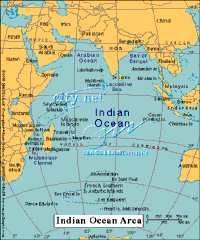 Introduction
Introduction
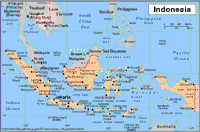
Over a century ago, on August 26,1883, the island volcano
of Krakatau ("Krakatoa") in Indonesia, a virtually unknown volcanic island with
a history of violent volcanic activity, exploded with devastating fury. The
eruption was one of the most catastrophic natural disasters in recorded history.
The effects were experienced on a global scale. Fine ashes from the eruption
were carried by upper level winds as far away as New York City. The explosion
was heard more than 3000 miles away. Volcanic dust blew into the upper
atmosphere affecting incoming solar radiation and the earth's weather for
several years.
A series of large tsunami waves generated by the main
explosion, some reaching a height of nearly 40 meters (more than 120 feet) above
sea level, killed more than 36,000 people in the coastal towns and villages
along the Sunda Strait on Java and Sumatra islands. Tsunami waves were recorded
or observed throughout the Indian Ocean, the Pacific Ocean, the American West
Coast, South America, and even as far away as the English Channel.
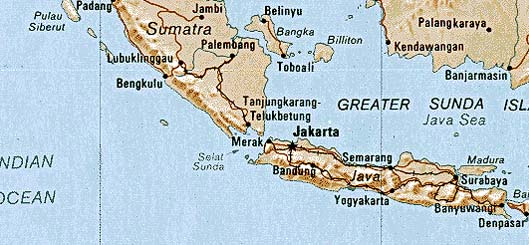
Location and Geologic Setting of the Krakatau (Krakatoa)
Volcano
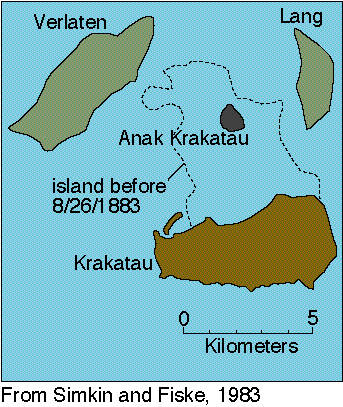 Krakatau
(Krakatoa) is located in the Sunda Strait, 40 km off the west coast of Java on
the island of Rakata in Indonesia. The geographical coordinates of Krakatoa are
16.7 S. Latitude and 105.4 E. Longitude. Krakatoa is one of the volcanoes of the
Sunda volcanic arc. The volcano was formed by the subduction of the
Indian-Australia Plate under the Eurasian Plate.
Krakatau
(Krakatoa) is located in the Sunda Strait, 40 km off the west coast of Java on
the island of Rakata in Indonesia. The geographical coordinates of Krakatoa are
16.7 S. Latitude and 105.4 E. Longitude. Krakatoa is one of the volcanoes of the
Sunda volcanic arc. The volcano was formed by the subduction of the
Indian-Australia Plate under the Eurasian Plate.
At its peak, Krakatoa reached a height of 790 m (2,600
ft.) above sea level. Its first known eruption
occurred in 416 A. D. However, this eruption destroyed the volcano of Krakatoa
which collapsed and formed a 4-mile wide caldera. The islands of Verlaten and
Lang are remnants of this older volcano. Subsequently, three volcanoes combined
to form the island of Krakatau.
Thus Krakatoa was the remnant of the old volcano which
had not erupted for 200 years. Prior to the great 1883 eruption of Krakatoa,
Rakata island was made of three volcanoes and at least one older caldera. The
volcanic cones aligned in a north-south direction. The northernmost was called
Poeboewetan and the southernmost was called Rakata. Overall approximate
dimensions of Krakatoa were 5 by 9 Kilometers.
Chronology of Events Prior to the Great August 26, 1883
Eruption
After a long period of inactivity (about 200 years),
Krakatoa became active again in early 1883. The first indication that something
was happening on Krakatoa was when a large earthquake struck the area. Seismic
activity became stronger until May 20,1883, when the volcano abruptly came to
life. The initial explosive eruptions of Krakatoa could be heard 160 km away.
Steam and ash could be seen rising 11km above the summit of the volcano. By
August 11, 1883. three vents were actively erupting. Eleven other vents were
ejecting smaller quantities of steam, ash and dust.
Around 1 pm on the 26th of August 1883, the explosions
became more frequent occurring on the average every 10 minutes. Sailors on a
ship, 120 km away from the island reported a black cloud of smoke rising above
the volcano. At the time the rim of Krakatoa's crater was approximately 1,000
meters in diameter and had and average depth of 50 meters. The volcano' s
central vent was blocked by a plug of solid lava and underneath it pressure was
rapidly building up.
The Great Eruption
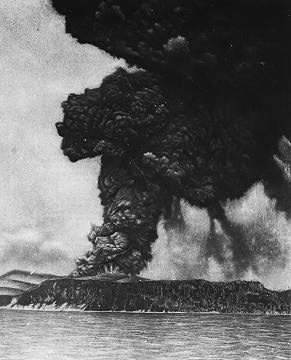 The
renewed activity in May 1883 culminated in four gigantic explosions on August 26
and 27 of the same year. On the afternoon of August 26, 1883, (27 August local
date) at 17: 07 Greenwich time (GMT), the first of these four violent explosions
begun. A black cloud of ash was initially observed. It rose 17 miles (27
kilometers) above Krakatoa. In the morning of the next day, on August 27, 1883,
at 05:30, 06:44 and 10:02 GMT, three more violent eruptions occurred. It was the
paroxysmal eruption which occurred at 10:02 which blew away the northern
two-thirds of the island. This was the most severe violent volcanic explosion on
Earth in modern times. The explosion was followed by the collapse of the
unsupported volcanic chambers of Krakatoa forming the huge underwater caldera.
It was this explosion and collapse of Krakatoa that generated catastrophic
tsunami waves as high as 37 meters. (120 ft.) that caused havoc and destruction
in the Sunda Strait.
The
renewed activity in May 1883 culminated in four gigantic explosions on August 26
and 27 of the same year. On the afternoon of August 26, 1883, (27 August local
date) at 17: 07 Greenwich time (GMT), the first of these four violent explosions
begun. A black cloud of ash was initially observed. It rose 17 miles (27
kilometers) above Krakatoa. In the morning of the next day, on August 27, 1883,
at 05:30, 06:44 and 10:02 GMT, three more violent eruptions occurred. It was the
paroxysmal eruption which occurred at 10:02 which blew away the northern
two-thirds of the island. This was the most severe violent volcanic explosion on
Earth in modern times. The explosion was followed by the collapse of the
unsupported volcanic chambers of Krakatoa forming the huge underwater caldera.
It was this explosion and collapse of Krakatoa that generated catastrophic
tsunami waves as high as 37 meters. (120 ft.) that caused havoc and destruction
in the Sunda Strait.
Photo of the Krakatoa eruptive activity a few
hours before the major explosions (taken on August 26, 1883 from a ship crossing
the Sunda Strait.
A Phreatomagmatic Event
Krakatoa's paroxysmal explosion was "phreatomagmatic" .
Ocean water entered the magmatic chambers of the volcano when its walls begun to
rupture. Super heated steam built tremendous pressure which, in turn, resulted
in the large explosion of the volcano. The violent explosion of released gases
blasted huge quantities of ash, cinders, pumice, bombs, and larger blocks
skyward. The explosion was followed by the collapse of the volcanic remnants
into the empty magmatic chambers, thus forming a submerged caldera.
Magnitude of the 1883 Eruption of Krakatoa
The 1883 eruption of Krakatoa has been assigned a
Volcanic Explosivity Index or VEI of 6 which rates as "colossal". To be assigned
a VEI rating of 6, a volcanic eruption must have a plume height over 25 km and a
displacement volume ranging between 10 and 100 km3 (cubic kilometers). Eruptions
of this size occur only once every few hundred years on earth.
The total energy released by the four main events of the
1883 eruption was equivalent to 200 megatons of TNT. Most of this energy was
released by the third paroxysmal explosion which has been estimated to be
equivalent to an explosion of 150 megatons of TNT. To understand the magnitude
of the Krakatoa explosion, it will suffice to say that the Hiroshima atomic bomb
was only about 20 kilotons).
(Schematic of Krakatoa before the 1883 explosion)
Volume of Material Ejected by the Volcanic Explosion
The amount of ejected material from the eruption of
Krakatoa into the atmosphere is estimated to have been about 21 cubic km (appr.
11 cubic miles)
What was left of Krakatoa after the Explosion
When Krakatoa erupted in 1883, the entire northern
portion of the island was blown away.
After the explosions and the collapse of unsupported
remnants into the newly formed caldera, only 1/3 of the volcano remained above
sea level. What remained were a few small islands marking the previous cone of
the volcano and some small new islands of steaming pumice and ash to the north.
One of the small islands that were born was "Anak Krakatau" or Krakatoa's Child
which is at present an extremely active young volcano, which at some point in
the distant future may explode with the same violence as Krakatoa.
(Schematic of what remained of Krakatoa following the 1883
explosion)
Local and Global Effects of the August 26,1883 Krakatoa
Eruption
Effects in the Immediate Vicinity
Blast waves cracked walls and broke windows up to 160 km.
away. Vibrations smashed shop windows as far as 80 miles away. Ships navigating
the seas near Krakatoa reported that in certain areas floating pumice had formed
a layer about 3 meters thick. Other ships, 160 miles off, reported that their
decks were covered with volcanic dust three days after the end of the eruption.
The dust cloud from the eruption completely covered the
area, and it was dark even 257 miles away from the volcano. Darkness covered the
Sunda Straits from 11 a.m. on the 27th until dawn the next day. This darkness
lasted more than 24 hours at places which were 130 miles away and 57 hours at
places which were 50 miles away. In the immediate area, total darkness continued
for three days.
Rain of Volcanic Ash and Pumice
There was a rain of volcanic ash and pumice from the
eruptions. In the nearby islands everything was buried under a thick layer of
ash. Plant and animal life did not begin to reestablish itself to any degree in
these nearby islands for nearly five years.
Near the volcano huge masses of pumice from the eruption
floated in the sea and were thick enough to interfere with navigation. Pumice
formed large and thick floating rafts some of which crossed the Indian Ocean in
a 10 month period. Others such rafts of pumice reached Melanesia, and were still
afloat two years after the eruption. Volcanic ash and such debris from
Krakatoa's eruption reached as far west as the island of Madagascar. Quantities
of dust from the eruption precipitated on the decks of vessels as far as 1,600
miles away. Ash fell on Singapore, which was 840 km away, and on Cocos Island
(Keeling) 1,155 km to the SW. Similar precipitation of ash occurred on ships at
sea more than 6,000 Km away in a WNW direction.
Krakatoa's Explosion Heard More than 2,000 Miles Away
Krakatoa's tremendous explosions were heard throughout
the area and beyond, over 1/3rd of the earth's surface. They were heard as far
away as 2,200 miles (3,540 kilometers) away in Australia, and even as far away
as Rodriguez Island which is 2,908 miles (4,653 km) away to the west-southwest,
in the Indian Ocean about 1,000 miles (1,600 km) east of Madagascar. People on
Rodrigues Island described the sounds to be like the distant roar of firing
canons. The sounds continued at intervals of three to four hours during the
night.
Atmospheric Shock Waves Recorded Throughout the World
Atmospheric pressure shock waves from the explosions of
Krakatoa circled the earth seven times and were recorded by barographs
throughout the world. Barographic records documented the shock waves from the
paroxysmal explosion of Krakatoa by as many 7 times, as these waves bounced back
and forth between the site of the eruption site and its antipodes on the earth
for 5 days following the explosion.
Upper Atmosphere Effects
Ash from the eruptions was propelled to a height of 50
miles (80 kilometers) in the upper atmosphere blocking the sun and plunging the
surrounding region into darkness for two and a half days.
Dust and ash from the eruption encircled the Earth in 13
days forming a cloud which, by September 9, 1883, had covered completely the
upper atmosphere along a belt in the equatorial zone. Three months after the
eruption this belt of volcanic dust of fine particles of dust had spread to
higher latitudes causing unusually spectacular red sunsets and other interesting
atmospheric effects. Blue and green suns were also observed. Breathtaking
sunsets were observed during the winter months of 1884 in both American and
Europe. Unusual sunsets continued for almost 3 years.
Climatic Changes
It has been estimated that at least 21 cubic Km (appr. 11
cubic mile) was ejected from the eruption of Krakatoa and that at least 1 cubic
mile of the finer material was blown to a height of about 17 miles (27 Km). The
volcanic dust blown into the upper atmosphere was carried several times around
the earth by air currents. This volcanic dust veil not only created the
spectacular atmospheric effects described previously but acted also as a solar
radiation filter, reducing the amount of sunlight reaching the surface of the
earth. In the year following the eruption, global temperatures were lowered by
as much as 1.2 degree Centigrade on the average. Weather patterns continued to
be chaotic for years and there were major climatological changes which affected
the entire globe. Temperatures did not return to normal until five years later,
in 1888.
Eruptions of Krakatoa Prior to 1883
Violent volcanic activity has been known to exist in this
region of Indonesia since early historic ages. In about 416 A.D., according to
ancient Javanese scriptures, a great eruption" of Krakatau (Krakatoa) must have
taken place. It was this violent early eruption that formed the three islands of
Rakata, Panjang, and Sertung and created a 4-mile (7-km) wide caldera.The
islands of Krakatau, Verlaten, and Lang are remnants of this volcano.
The earliest recorded eruption of Krakatoa was a moderate
one between May 1680 and November 1681. This eruption destroyed all of the lush
vegetation on the island. Large quantities of rock pumice and ash fell into the
sea.
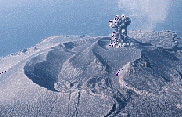 Subsequent and
Recent Eruptions of Krakatoa
Subsequent and
Recent Eruptions of Krakatoa
As reported previously, prior to the 1883 eruption,
Krakatoa was an island made of three volcanoes and at least one older caldera.
The eruption of 1883 destroyed most of of the island, leaving only a remnant.
(Recent photo of Anak Krakatau)
For the next few years, what used to be Krakatoa was
relatively quiet until, on January 25,1925, a small volcanic cone broke through
the water in the caldera of old Krakatoa. Krakatoa not only was not dead but had
given birth. The new volcanic island was named Anak Krakatau or Child of
Krakatoa. In 1927, occasional weak eruptions of this small volcano began. In
later years, the small eruptions became more frequent gradually building up this
new island volcano to a much larger size.
in December of 1959, Anak Krakatau became very active.
The renewed activity attracted a great deal of attention. In January of 1960, a
team of scientists visited Anak Krakatau to study this renewed activity. They
reported that Anak Krakatau had grown to a minimum diameter of about one mile
and was 545 ft. tall. They reported that the crater on the south side of the
island was 2,000 ft. in diameter and contained a growing cinder cone which was
300 ft. in diameter and 150 ft. high. This new cinder cone had formed in about a
month, since the resumption of activity. The scientists observed that the
explosive eruption were of the Vulcanian-type and, at the time, they were
occurring at intervals ranging from 1/2 to 10 minute . They reported that the
new explosive eruptions included pyroclastic ranging in size from fine ash to
boulders and that the largest explosions produced turbulent clouds of ash that
rose 4,000 ft. above the volcanic vent. This renewed activity of Anak Krakatau
lasted for almost four years, ending in 1963.
Since 1963, according to reports, Anak Krakatau had at
least nine episodes of activity most lasting less than one year. The volcano's
activity continued into the 1990's. As of the writing of this report, the most
recent episode of eruption began in March of 1994 and continued to March of
1995. This activity was very similar to the 1959-1963 eruptions.

The 1883 Eruption of Krakatoa was not the Largest Known
in Recorded History
Although large and catastrophic, the 1883 eruption of
Krakatoa was not the largest known in recorded history. The explosion of the
volcano of Santorini (Thera) which occurred in the Aegean Sea in in the
fifteenth century BC, although assigned also a VEI of 6, was at least six and
one half times greater than that of Krakatoa. Also the volcanic explosion of
Mount Vesuvius in 79 A.D was greater than that of Krakatoa.
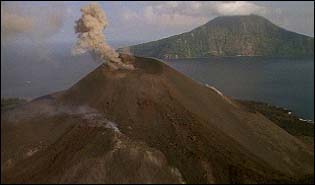 Future Great
Eruptions of Anak Krakatau, the Child of Krakatoa
Future Great
Eruptions of Anak Krakatau, the Child of Krakatoa
Undoubtedly the eruptions will continue and Anak Krakatau,
the Child of Krakatoa will keep on growing in size. Undoubtedly, at some time in
the future, perhaps a few hundred years from now, a large explosion similar to
that of 1883 can be expected. It is only a question of time.
Here are some highlights from their summary of effects:
1. The explosions were heard on Rodriguez Island, 4653 km distant across the
Indian Ocean, and over 1/13th of the earth's surface.
2. Ash fell on Singapore 840 km to the N, Cocos (Keeling) Island 1155 km to
the SW, and ships as far as 6076 km WNW. Darkness covered the Sunday Straits
from 11 a.m. on the 27th until dawn the next day.
3. Giant waves reached heights of 40 m above sea level, devastating
everything in their path and hurling ashore coral blocks weighing as much as 600
tons.
4. At least 36,417 people were killed, most by the giant sea waves, and 165
coastal villages were destroyed.
5. When the eruption ended only 1/3 of Krakatau, formerly 5x9 km, remained
above sea level, and new islands of steaming pumice and ash lay to the north
where the sea had been 36 m deep.
6. Every recording barograph in the world documented the passage of the
airwave, some as many as 7 times as the wave bounced back and forth between the
eruption site and its antipodes for 5 days after the explosion.
7. Tide gauges also recorded the sea wave's passage far from Krakatau. The
wave "reached Aden in 12 hours, a distance of 3800 nautical miles, usually
traversed by a good steamer in 12 days".
8. Blue and green suns were observed as fine ash and aerosol, erupted perhaps
50 km into the stratosphere, circled the equator in 13 days.
9. Three months after the eruption these products had spread to higher
latitudes causing such vivid red sunset afterglows that fire engines were called
out in New York, Poughkeepsie, and New Haven to quench the apparent
conflagration. Unusual sunsets continued for 3 years.
10. Rafts of floating pumice-locally thick enough to support men, trees, and
no doubt other biological passengers-crossed the Indian Ocean in 10 months.
Others reached Melanesia, and were still afloat two years after the eruption.
11. The volcanic dust veil that created such spectacular atmospheric effects
also acted as a solar radiation filter, lowering global temperatures as much as
1.2 degree C in the year after the eruption. Temperatures did not return to
normal until 1888.
 Introduction
Introduction

 Introduction
Introduction


 Krakatau
(Krakatoa) is located in the Sunda Strait, 40 km off the west coast of Java on
the island of Rakata in Indonesia. The geographical coordinates of Krakatoa are
16.7 S. Latitude and 105.4 E. Longitude. Krakatoa is one of the volcanoes of the
Sunda volcanic arc. The volcano was formed by the subduction of the
Indian-Australia Plate under the Eurasian Plate.
Krakatau
(Krakatoa) is located in the Sunda Strait, 40 km off the west coast of Java on
the island of Rakata in Indonesia. The geographical coordinates of Krakatoa are
16.7 S. Latitude and 105.4 E. Longitude. Krakatoa is one of the volcanoes of the
Sunda volcanic arc. The volcano was formed by the subduction of the
Indian-Australia Plate under the Eurasian Plate. The
renewed activity in May 1883 culminated in four gigantic explosions on August 26
and 27 of the same year. On the afternoon of August 26, 1883, (27 August local
date) at 17: 07 Greenwich time (GMT), the first of these four violent explosions
begun. A black cloud of ash was initially observed. It rose 17 miles (27
kilometers) above Krakatoa. In the morning of the next day, on August 27, 1883,
at 05:30, 06:44 and 10:02 GMT, three more violent eruptions occurred. It was the
paroxysmal eruption which occurred at 10:02 which blew away the northern
two-thirds of the island. This was the most severe violent volcanic explosion on
Earth in modern times. The explosion was followed by the collapse of the
unsupported volcanic chambers of Krakatoa forming the huge underwater caldera.
It was this explosion and collapse of Krakatoa that generated catastrophic
tsunami waves as high as 37 meters. (120 ft.) that caused havoc and destruction
in the Sunda Strait.
The
renewed activity in May 1883 culminated in four gigantic explosions on August 26
and 27 of the same year. On the afternoon of August 26, 1883, (27 August local
date) at 17: 07 Greenwich time (GMT), the first of these four violent explosions
begun. A black cloud of ash was initially observed. It rose 17 miles (27
kilometers) above Krakatoa. In the morning of the next day, on August 27, 1883,
at 05:30, 06:44 and 10:02 GMT, three more violent eruptions occurred. It was the
paroxysmal eruption which occurred at 10:02 which blew away the northern
two-thirds of the island. This was the most severe violent volcanic explosion on
Earth in modern times. The explosion was followed by the collapse of the
unsupported volcanic chambers of Krakatoa forming the huge underwater caldera.
It was this explosion and collapse of Krakatoa that generated catastrophic
tsunami waves as high as 37 meters. (120 ft.) that caused havoc and destruction
in the Sunda Strait. Subsequent and
Recent Eruptions of Krakatoa
Subsequent and
Recent Eruptions of Krakatoa Future Great
Eruptions of Anak Krakatau, the Child of Krakatoa
Future Great
Eruptions of Anak Krakatau, the Child of Krakatoa